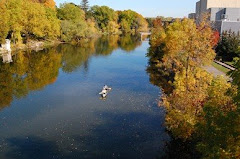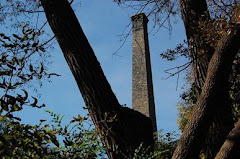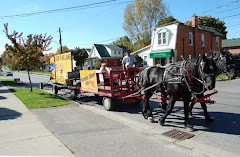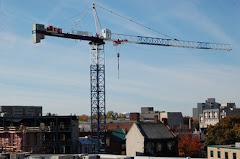The below remarks are from the original notice about the first meeting of Land Is More Important Than Sprawl (LIMITS) as discussed in my Guelph Beat column in today's Echo. It's got the most basic and important of the information involving why LIMITS is fighting to protect this piece of land.
I plan on making a pilgrimage down that way myself, hopefully in the not too distant future. I'd love to check it out first hand before and if it disappears. Anyway, here what LIMITS has to say about it's cause:
This upcoming spring, the City of Guelph is hoping to finally start building their Hanlon Creek Business Park, a sprawling 675-acre industrial development on the south end of Guelph. Located on the west side of the Hanlon, across from the existing Hanlon Business Park, the land is a mix of forest, meadow, farmland, and a provincially significant wetland.
Located in the center of the proposed industrial development is a spectacular Old Growth forest, the only one of its kind left in the area. Approximately 165 acres, this forest contains hundreds of rare and old growth trees, and on the south end of the proposed industrial development is a hop hornbeam tree that is believed to be about 500 years old. This tree is located within a grove of 150-230 year old sugar maples.
Many of these trees were alive long before European settlers founded Guelph, alive even before the first French Jesuit missionaries explored this land in the 1600s. Archaeologists doing a survey for the HCBP lands recently found evidence that Indigenous people used this area as long as 11,000 years ago.
Also noteworthy is that the city's Downey well, which supplies 20% of Guelph's drinking water, is located about 800 meters from the proposed site for the HCBP. This well is fed by the Hanlon Creek, which travels through the proposed industrial park, and even further, the proposed site includes a recharge zone for the Hanlon Creek. The Hanlon Creek is a tributary of the Speed River, which is one of the four major tributaries of the Grand River.
According to the city's promotional publication on the HCBP, they want to surround this important creek and Guelph's last old growth forest with approximately 370 acres of industrial buildings and 74 acres of new roads. It doesn't take an environmentalist to know that this would permanently and seriously degrade the land.
For the survival of this land, the Hanlon Creek, and Guelph's last viable Old Growth forest, as well for the long-term health and survival of residents of Guelph, we believe there are better things to do with this land than build a massive industrial 'park'. Combining a look at the economic depression we are entering, the coming food security challenges, the severe threat of climate change, the mounting health problems of our industrial system, and much more, a powerful and comprehensive case can be made against the HCBP. We are excited to be working on this and to see where it can go.
Currently we are only a few people, and we would love to diversify and be part of a strong community opposition to such reckless development. Please get in touch if you have any ideas or desires to help us with research, outreach, media stuff, developing ideas, and more. This kind of thing can be very fun to work on with others when the workload is shared.
LIMITS also has a Facebook group, but should you too believe in their cause, the best way to get involved is through e-mail: guelphlimits@gmail.com.
I plan on making a pilgrimage down that way myself, hopefully in the not too distant future. I'd love to check it out first hand before and if it disappears. Anyway, here what LIMITS has to say about it's cause:
This upcoming spring, the City of Guelph is hoping to finally start building their Hanlon Creek Business Park, a sprawling 675-acre industrial development on the south end of Guelph. Located on the west side of the Hanlon, across from the existing Hanlon Business Park, the land is a mix of forest, meadow, farmland, and a provincially significant wetland.
Located in the center of the proposed industrial development is a spectacular Old Growth forest, the only one of its kind left in the area. Approximately 165 acres, this forest contains hundreds of rare and old growth trees, and on the south end of the proposed industrial development is a hop hornbeam tree that is believed to be about 500 years old. This tree is located within a grove of 150-230 year old sugar maples.
Many of these trees were alive long before European settlers founded Guelph, alive even before the first French Jesuit missionaries explored this land in the 1600s. Archaeologists doing a survey for the HCBP lands recently found evidence that Indigenous people used this area as long as 11,000 years ago.
Also noteworthy is that the city's Downey well, which supplies 20% of Guelph's drinking water, is located about 800 meters from the proposed site for the HCBP. This well is fed by the Hanlon Creek, which travels through the proposed industrial park, and even further, the proposed site includes a recharge zone for the Hanlon Creek. The Hanlon Creek is a tributary of the Speed River, which is one of the four major tributaries of the Grand River.
According to the city's promotional publication on the HCBP, they want to surround this important creek and Guelph's last old growth forest with approximately 370 acres of industrial buildings and 74 acres of new roads. It doesn't take an environmentalist to know that this would permanently and seriously degrade the land.
For the survival of this land, the Hanlon Creek, and Guelph's last viable Old Growth forest, as well for the long-term health and survival of residents of Guelph, we believe there are better things to do with this land than build a massive industrial 'park'. Combining a look at the economic depression we are entering, the coming food security challenges, the severe threat of climate change, the mounting health problems of our industrial system, and much more, a powerful and comprehensive case can be made against the HCBP. We are excited to be working on this and to see where it can go.
Currently we are only a few people, and we would love to diversify and be part of a strong community opposition to such reckless development. Please get in touch if you have any ideas or desires to help us with research, outreach, media stuff, developing ideas, and more. This kind of thing can be very fun to work on with others when the workload is shared.
LIMITS also has a Facebook group, but should you too believe in their cause, the best way to get involved is through e-mail: guelphlimits@gmail.com.

















No comments:
Post a Comment